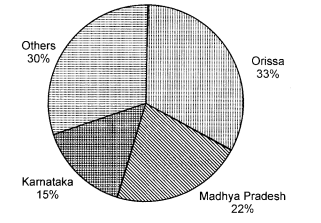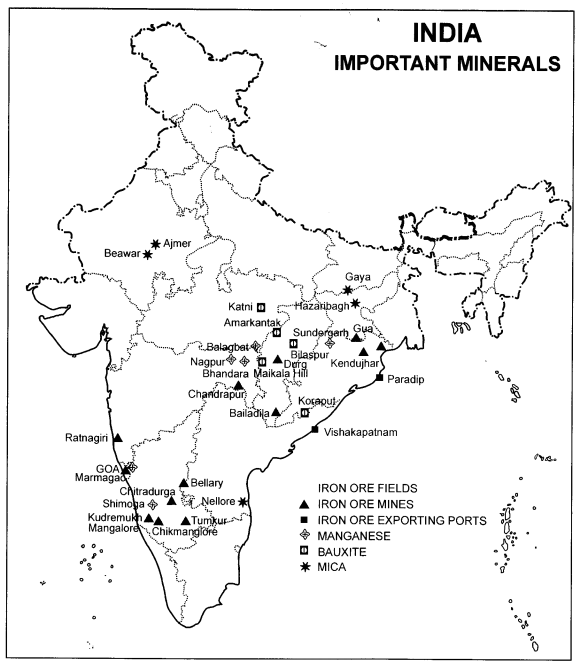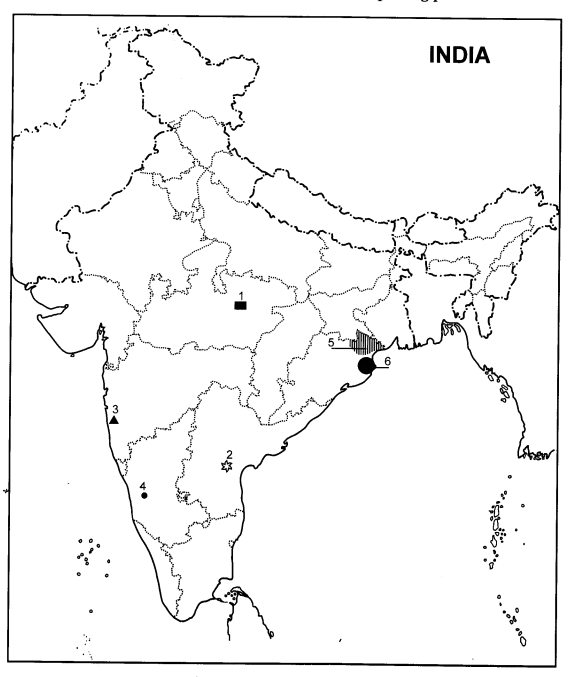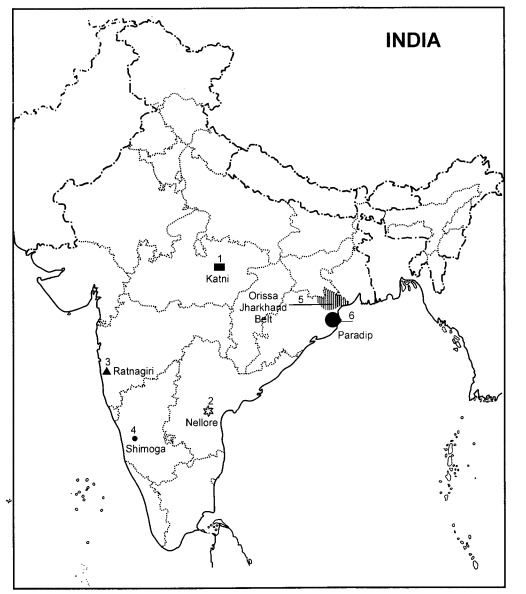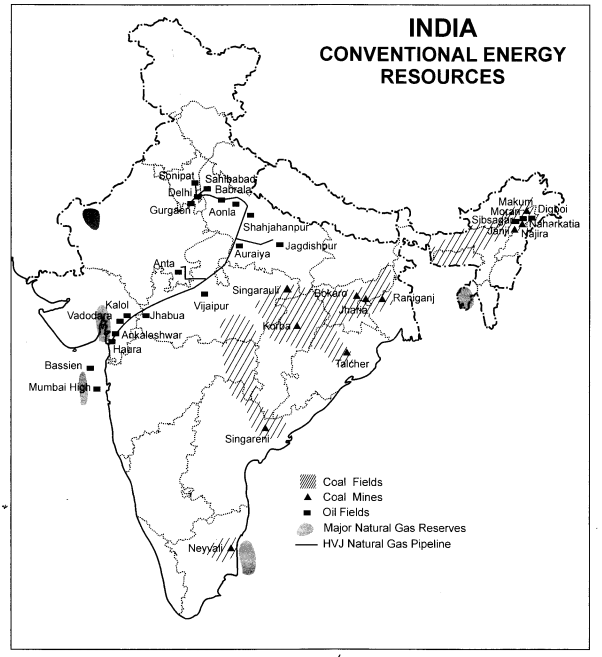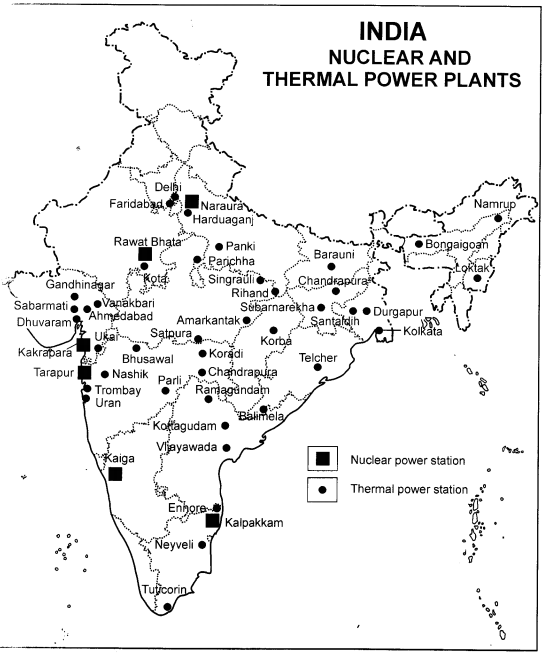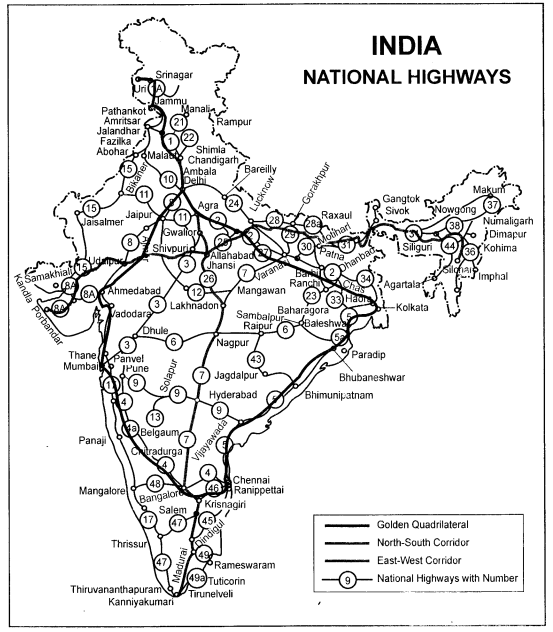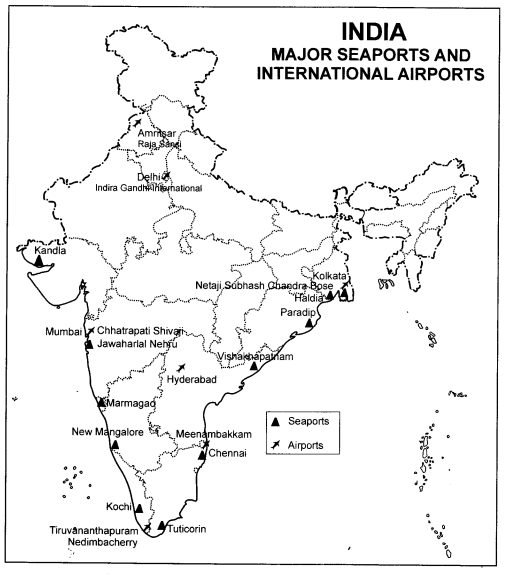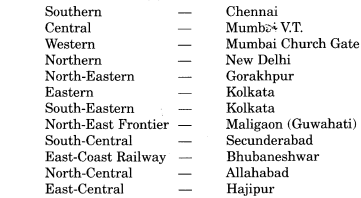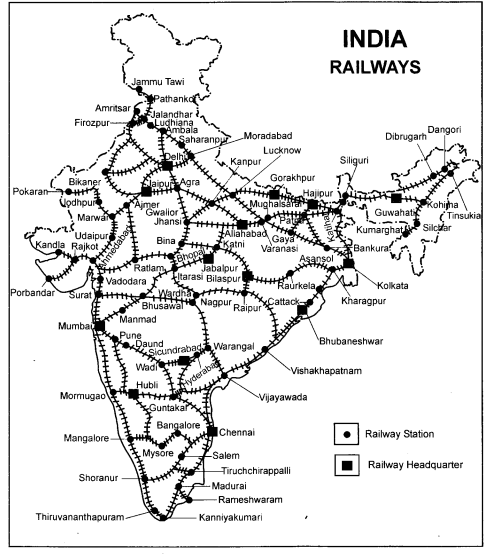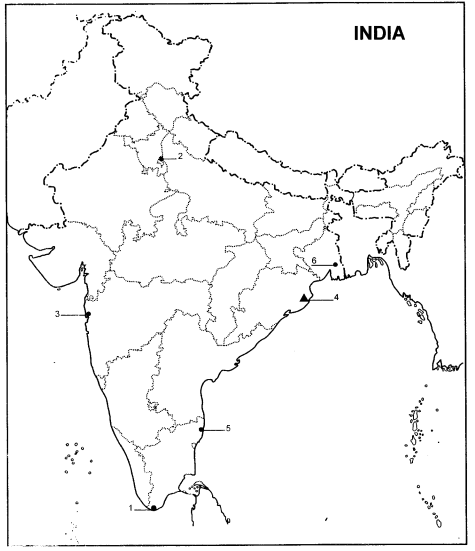CBSE Class 10 History Chapter 2 Extra Questions and Answers The Nationalist Movement in Indo-China Pdf free download are part of Extra Questions for Class 10 Social Science. Here we have given NCERT Extra Questions for Class 10 Social Science SST History Chapter 2 The Nationalist Movement in Indo-China.
Learnintsa.com Committed to provides Extensive NCERT Solutions for Class 10 History Chapter 2 The Nationalist Movement in Indo-China, Students can read and score more marks in your CBSE board examination.
The Nationalist Movement in Indo-China Class 10 Extra Questions History Chapter 2
VERY SHORT ANSWER QUESTIONS
Answers should not exceed 30 words.
Question 1.
Which modern countries were part of Indo-China ?
Answer:
Indo-China comprises the modern countries of Vietnam, Laos and Cambodia.
Question 2.
State one feature of early history of Indo-China.
Answer:
Its early history shows many different groups of people living there under the shadow of the powerful empire of China. Even after independence, its rulers continued to maintain the Chinese system of government as well as Chinese culture.
Question 3.
How was the maritime silk route useful for Vietnam ? [CBSE 2015]
Answer:
Vietnam was linked through the maritime silk route that brought in goods, people and ideas.
Question 4.
What was the importance of the port of Faibo ?
Answer:
This port was founded by Portuguese merchants. It was one of the ports used by European trading companies much before the nineteenth century.
Question 5.
What was one most visible form of French control over Vietnam ?
Answer:
The most visible form of French control was military and economic domination but the French also built a system that tried to reshape the culture of the Vietnamese.
Question 6.
Who was Francis Gamier ?
Answer:
Francis Gamier was part of the French team that explored the Mekong river. In 1873 he was commissioned by the French to try and establish a French colony in Tonkin in the north. Gamier carried out an attack on Hanoi but was killed in the fight.
Question 7.
French colonisation of Vietnam was based on which two issues ?
Answer:
- To supply natural resources.
- Civilising mission i.e., to bring the benefits of civilisation to backward people.
Question 8.
By 1931 what was the position of Vietnam as an exporter of rice in the world ?
Answer:
By 1931 Vitenam had become the third largest exporter of rice in the world.
Question 9.
According to Bernard what were the barriers to economic growth in Vietnam ? Mention any three.
Answer:
- High population levels.
- Low agricultural productivity.
- Extensive indebtedness amongst the peasants.
Question 10.
What do you understand by indentured labour ?
Answer:
- It was a form of labour widely used in the plantations from the mid-nineteenth century.
- Labourers worked on the basis of contracts that did not specify any rights of labourers but gave immense power to employers.
- Employers could bring criminal charges against labourers and punish and jail them for non-fulfillment of contracts.
Question 11.
What was the basis of colonial economy in Vietnam ?
Answer:
The colonial economy in Vietnam was primarily based on rice cultivation and mbber plantations owned by the French and a small Vietnamese elite.
Question 12.
Who was Jean Dupuis ?
Answer:
Jean Dupuis was a French weapons merchant who explored the regions in the hope of making profit from trade. He was one of those who persuaded the French to try and establish a base in Vietnam.
Question 13.
Who were called colons in Vietnam ? [CBSE 2016]
Answer:
French citizens living in Vietnam were called colons.
Question 14.
State any one problem that was faced by the French in the field of education if. Vietnam.
Answer:
The problem was that the elites in Vietnam were powerfully influenced by the Chinese culture.
Question 15.
There were two opinions about the medium of education in Vietnam. State a ay one opinion.
Answer:
One opinion was that the French language should be the medium of instruction because by learning the language they would be introduced to the culture and civilisation of France. This would help create an ‘Asiatic France solidly tied to European France.’
Question 16.
How were Vietnamese represented in the textbooks ?
Answer:
The Vietnamese were represented as primitive and backward, capable of manual labour but not of intellectual reflection. They could work in the fields but not rule themselves.
Question 17.
When was Tonkin Free School started and why ?
Answer:
The Tonkin Free School was started in 1907 to provide a western style education.
Question 18.
How did the school encourage the Vietnamese to look modem ?
Answer:
The school encouraged the adoption of Western styles such as having a short hair cut. For the Vietnamese this meant a major break with their own identity since they traditionally kept long hair.
Question 19.
By 1920s the students in Vietnam were publishing nationalist journals. Name one such journal.
Answer:
Annanese Student.
Question 20.
How did the teachers oppose the French educational system with silent resistance ?
Answer:
While teaching, Vietnamese teachers quietly modified the text and criticised what was stated. As the number of teacher in lower classes was large, it was difficult to control what was actually taught.
Question 21.
State any one difference between the French part of Hanoi and the ‘native quarter’.
Answer:
The French part of Hanoi was built as a beautiful and clean city with wide avenues and well-laid-out sewer system, while the ‘native quarter’ was not provided with any modern facilities.
Question 22.
In which year was the modern part of Hanoi struck by bubonic plague ?
Answer:
In 1903, the modern part of Hanoi was struck by bubonic plague.
Question 23.
What does the rat menace show about the French in Vietnam ?
Answer:
The rat menace shows the limits of French power and contradictions in their ‘civilising mission’.
Question 24.
What were the religious beliefs of the Vietnamese ?
Answer:
- Vietnam’s religious beliefs were a mixture of Buddhism, Confucianism and local practices.
- The Vietnamese tendency was to revere the supernatural.
Question 25.
When and why was the Scholars Revolt started ?
Answer:
- The Scholars Revolt started in 1868. 4
- It was an early movement against French control and the spread of Christianity. This revolt was led by officials at the imperial court angered by the spread of Catholicism and French power.
Question 26.
What do you understand by syncretic traditions ?
Answer:
Syncretic traditions aim to bring together different beliefs and practices seeing their essential unity rather than difference.
Question 27.
What was a concentration camp ?
Answer:
Concentration camp was a prison where people were detained without due process of law. The word evokes an image of a place of torture and brutal treatment.
Question 28.
Who was founder of Hoa Hao movement ?
Answer:
The founder of Hoa Hao movement was Huynh Phu So.
Question 29.
State any one main idea of Phan Boi Chau.
Answer:
He maintained that first the foreign enemy should be driven out, and after their nation’s independence was restored other things could be done later.
Question 30.
Describe one main idea of Phan Chu Trinh.
Answer:
- He was intensely hostile to the monarchy and opposed to the idea of resisting the French with the help of the court.
- His desire was to establish a democratic republic.
Question 31.
Which provinces were called the ‘electrical fuses’ of Vietnam ?
Answer:
Nghe An and Ha Tinh were called the ‘electrical fuses’ of Vietnam.
Question 32.
Which was Phan Boi Chau’s most influential book ?
Answer:
The History of the Loss of Vietnam was Phan’s most influential book.
Question 33.
What was the main clause of the peace negotiations in Geneva ?
Answer:
In the peace negotiations in Geneva, the Vietnamese were persuaded to accept the division of the country. North and south were split; Ho Chi Minh and the communists took power in the north while Bao Dai’s regime was put in power in the south.
Question 34.
What is a Republic ?
Answer:
Republic is a form of government based on popular consent and popular representation. It is based on the power of the people as opposed to monarchy.
Question 35.
When did ‘go east movement’ become popular ?
Answer:
In the first decade of the twentieth century, a ‘go east movement’ became popular.
Question 36.
When was the monarchy overthrown in China and what was the result ?
Answer:
In 1911, monarchy was overthrown by a popular movement under Sun Yat-sen and a republic was setup.
Question 37.
Why did the US enter into the war in Vietnam ?
Answer:
With the help of the Ho Chi Minh government in the north, the NLF fought for the unification of the country. The US feared that this alliance would help the communists to gain power. This made the US worried and it decided to intervene decisively sending in troops and arms.
Question 38.
Why the phase of struggle with the US is considered brutal ? State one reason.
Answer:
The phase of struggle with the US was considered brutal because civilians died in large numbers. Many villages were destroyed and jungles decimated as a result of use of chemical weapons – Napalm, Agent Orange, and phosphorous bombs.
Question 39.
How Vietnam was divided in Geneva ?
Answer:
North and south were split: Ho Chi Minh and the communists took power in the north while Bao Dai’s regime was put in power in the south.
Question 40.
Which film was made in Hollywood in support of war in Vietnam in 1968 ?
Answer:
John Wayne’s Green Berets.
Question 41.
What is the importance of Ho Chi Minh trail ?
Answer:
- It symbolises how the Vietnamese used their limited resources to great advantage.
- It was used to transport men and materials from the north to the south.
Question 42.
Who were Trung sisters ?
Answer:
Trung sisters were rebel women. They had fought against Chinese domination in 39-43 CE. They were idealised and glorified. It is said that they gathered a force of over 30,000 and resisted the Chinese for two years. When defeated they committed suicide instead of surrendering to the enemy.
Question 43.
When was peace settlement signed and with what results ?
Answer:
- A peace settlement was signed in Paris in January 1974.
- This ended the conflict with US.
Question 44.
When and how was Vietnam unified ?
Answer:
- After Paris Settlement, fighting between the Saigon regime and the NLF continued.
- The NLF occupied the presidential palace in Saigon on 30 April 1975 and unified Vietnam.
QUESTIONS OF 3/5 MARKS
Answers should be in about 80/100 words.
Question 1.
How the French established their control over Vietnam ? What were its results ?
Answer:
(1) The French established their control over Vietnam by their military power as
mentioned below :
- French troops landed in Vietnam in 1858 and by the mid 1880s they had established a firm grip over the northern region.
- After the Franco-Chinese war the French assumed control of Tonkin and Anaam.
- In 1887, French Indo-China was formed.
(2) Effects :
- There was conflict in all the spheres of life between the people of Vietnam and the French colonisers.
- French control was maintained through military and economic domination but they also tried to re-shape the culture of the Vietnamese. This led to the emergence of nationalism in Vietnam and the different sections of society fought against the French and their activities.
- As the French consolidated their position, the people in Vietnam began reflecting on the nature of the loss that Vietnam was suffering. This increased the nationalist resistance.
- The knitting together of a modern Vietnamese nation that brought the different communities together was in part the result of colonisation.
Question 2.
Describe any five steps taken by the French for the development of the Mekong Delta Region.
[CBSE 2015]
Answer:
The steps taken by the French for the development of the Mekong Delta Region were as mentioned below :
- The French built canals.
- They started the draining of lands to increase cultivation.
- A vast system of earthworks was built mainly with forced labour.
- Trans-Indo-China rail network was constructed. It linked the northern and southern parts of Vietnam and China. The final link with Yunan in China was completed by 1910.
- Another line linking Vietnam to Siam (Thailand), via the Cambodian capital Phnom Penh was also built.
Also see Textbook Question 2(b).
Question 3.
How did Paul Bernard argue in favour of economic development of Vietnam ? [CBSE2015]
Answer:
(1) Generally, the colonies serve the interests of the mother country. Paul Bernard believed that the economies of the colonies should be developed because the aim of acquiring colonies was to make profits. He argued that if the economy was developed and the standard of living of the people improved, they would buy more goods. The market would consequently expand, leading to better profits for French business.
(2) According to Bernard there were following barriers to the economic growth of Vietnam :
- High population level.
- Low agricultural productivity.
- Extensive indebtedness amongst the peasants.
(3) Bernard suggested that to reduce poverty and increase agricultural productivity, it was necessary to carry out land reforms as the Japanese had done in 1890s. However, this could not ensure sufficient employment. As the experience of Japan showed, industrialisation would be essential to create jobs.
Question 4.
Describe the features of colonial economy in Vietnam.
Answer:
The features of colonial economy in Vietnam were as mentioned below :
- The colonial economy was primarily based on rice-cultivation and rubber plantations owned by the French and a small Vietnamese elite.
- Rail and port facilities were set up to service this sector.
- Indentured Vietnamese labour was widely used in the rubber plantations.
- The French did little to industrialise the economy.
- In the rural areas, landlordism spread and the standard of living declined.
Question 5.
Why did French Policy makers want to educate the people of Vietnam ? What were the problems before the French in spreading education to the Vietnamese ?
Or
Describe the major problems in the Held of education for the French in Vietnam. [CBSE 2015]
Answer:
(1) French colonisation was based on economic exploitation as well as on the idea of a ‘civilising mission’ like the British in India. Education was seen as one way to civilise the ‘native’ or the Vietnamese people.
Secondly the French needed an educated local labour force.
(2) Problems : The French faced the problems in the sphere of education as mentioned below :
- They feared that once educated, the Vietnamese may begin to question colonial domination.
- The French citizens living in Vietnam, called colons, feared that they might lose their jobs as teachers, shopkeepers, policemen to the educated Vietnamese. Thus they opposed the idea of giving to the natives full access to education.
- In addition to above the elites in Vietnam were under the influence of Chinese culture. It was necessary for the French to counter that influence too.
Question 6.
“French tried to solve educational problems in Vietnam in different ways.” Support the statement with examples. [CBSE 2016]
Answer:
(1) Problems before French : See Question Number 5 above.
(2) To solve the problem in the educational field, the French took the steps as mentioned below :
- They systematically dismantled the traditional educational system. French schools were established for the Vietnamese e.g., Tonkin Free School.
- School textbooks glorified the French and justified colonial rule,
(1) The Vietnamese were represented as primitive and backward and capable of manual labour but not of intellectual reflection.
(2) The Vietnamese could work only in the fields and could not rule themselves,
(3) They were ‘skilled copyists’ but not creative. School children were told that only French rule could ensure peace in Vietnam. “Since the establishment of French rule the Vietnamese peasant no longer lives in constant terror of pirates. Calm is complete and the peasant can work with a good heart.” - Although the French opened schools to spread a Western-style education, they also adopted a policy of failing the Vietnamese students so that they could not qualify for better-paid jobs. For example, in 1925, in a population of 17 million, there were less than 400 who passed the examination.
- Results : The French policy of education resulted in resistance from the Vietnamese to their system of education.
Also see Textbook Question 2(a) and 3.
Question 7.
Why did the question of medium of education arise in Vietnam ? What were different opinions about it ? Explain.
Answer:
The elites in Vietnam were powerfully influenced by Chinese culture. To consolidate their power it was necessary for them to counter this influence. So they systematically dismantled the traditional educational system and established French schools for the Vietnamese. But the question arose about the medium of instruction in the educational system. Whether it should be French or Chinese used by elites. There was difference of opinion as mentioned below :
(1) Use of French language : It had following advantages :
- Vietnamese would know about French culture and civilisation,
- This would help create an ‘Asiatic France, solidly tied to European France’,
- The educated people in Vietnam would respect French sentiments and ideals. They would see the superiority of French culture, and work for the French.
Mixed use of languages : Other opinion was in favour of mixed use of languages i.e., use of Vietnamese in lower classes and French in the higher classes. It was argued that the few who learnt French and acquired French culture might be given French citizenship as a reward.
However in practice only a small fraction of the population – only the Vietnamese elite – could enroll in the schools and only a few among those admitted ultimately passed the school leaving examination.
Question 8.
Describe the major protest which erupted in Saigon Native Girls School in 1926 Vietnam. [CBSE 2015]
Answer:
(1) A major protest erupted in 1926 in the Saigon Native Girls School because a Vietnamese girl sitting in one of front seats was asked to move to the back of the class and allow a local French student to occupy the front bench. She refused. The principal, a colon (French people living in the colonies), expelled her, leading to a further spread of open protests. Seeing the situation getting out of control, the government forced the school to take the students back. The principal reluctantly agreed but warned the students, “I will crush all the Vietnamese under my feet. Ah! You wish my deportation. Know well that I will leave only after I am assured Vietnamese no longer inhabit Cochinchina.”
(2) Effects and Importance :
- Elsewhere the students fought against the colonial government’s effort to prevent the Vietnamese from qualifying for white collar jobs.
- The students were inspired by patriotic feelings that it was duty of the educated to fight for the benefit of society.
- This led to a conflict with the French.
- By the 1920s, students formed various political parties such as the Party of Young Annan.
- Students started publishing nationalist journals such as Annanese Student.
Question 9.
Compare the role and effect of education as envisaged by the French and the Vietnamese intellectuals.
Or
Why the schools in Vietnam had become an important place for political and cultural battles ?
Answer:
The schools in Vietnam had become an important place for political and cultural battles due to fact that the role and effect of education were different as envisaged by the French and the Vietnamese intellectuals.
- The French sought to strengthen their rule in Vietnam through the control of education.
- They tried to change the values, norms and perceptions of the people, to make them believe in the superiority of French civilisation and the inferiority of the Vietnamese.
- Vietnamese intellectuals, on the other hand, feared that Vietnam was losing not just control over its territory but its very identity.
- They thought their own culture and customs were being devalued and the people were developing a master-slave mentality.
As a result of above, the battle against French colonial education became part of the larger battle against colonialism and for independence.
Question 10.
“The measures taken by the French to control the spread of Bubonic plague in Hanoi created a serious problem.” Explain the statement.
Answer:
The measures taken by the French to control the spread of bubonic plague in Hanoi wfere as mentioned below :
- A rat hunt was started in 1902.
- The French hired Vietnamese workers and were paid for each rat they caught. Bounty was paid when a tail was given as proof of killing a rat.
Results :
- Thousands of rats were caught.
- Vietnamese got a lesson in the success of collective bargaining because they came together and successfully negotiated with the government for a higher bounty.
- The rat-catchers discovered new ways to earn more profit, such as clipping the tails of the rats and raising of rats to earn money. This led to scrapping of the bounty programme. The
spread of plague became a serious problem. It swept through the area in 1903 and the subsequent years.
Results and importance :
- The rat menace marks the limits of French power and contradictions in their ‘civilising mission’.
- The actions of the rat-catchers tell us of the numerous small ways in which colonialism was fought in everyday life.
Question 11.
How did nationalism emerge in Vietnam through the efforts of different sections of society to fight against the French ? Analyse. [CBSE 2016]
Answer:
Nationalism emerged in Vietnam through the efforts of different sections of society to fight against the French as mentioned below :
- Religious movements : The Christianity could not tolerate the reverence of super natural powers by the Vietnamese. This led to the Scholars Revolt in 1868 and Hoa Hao Movement in 1839.
These movements were against French control and spread of Christianity. They were anti¬colonial. Thus, these movements played an important role in arousing anti-colonial feelings in Vietnam. - In the late 19th century, the resistance to French domination was led by Confucian Scholars – Phan Boi Chau and Phan Chu Trinh.
- Another movement ‘Go East Movement’ in the first decade of the 20th century too helped in emergence of nationalism.
- Developments in China i.e., setting up a republic under Sun Yat-sen too aroused the feeling of nationalism in Vietnam.
Question 12.
Describe the role of religious groups in the development of anti-colonial feeling in Vietnam.
Answer:
In Vietnam, the French tried to control all areas of private and public life. People in Vietnam believed in Buddhism, Confucianism and local practices. They had an easy going attitude. They revered the supernatural powers. The Christianity, however, could not tolerate such feelings of the Vietnamese. This resulted in the following movements that were hostile to the western presence :
- The Scholars Revolt in 1868 — This revolt was led by officials at the imperial court angered by the spread of Catholicism and French power. This led to general uprising in Ngu An and Ha Tien provinces. The French crushed the movement but this uprising served to inspire other patriots to rise up against them.
- Hoa Hao in 1939 — See Textbook Exercise Question 1(6).
These movements were against the French and played an important role in arousing feelings of nationalism among the Vietnamese people.
Also see next questions on Phan Boi Chou and ‘Go East Movement’.
Question 13.
Evaluate the role of Phan Boi Chou as an activist to resist the French domination in 19th century.
Answer:
In the late 19th century, resistance to French domination was very often led by Confucian scholar-activists, who saw their world crumbling. One such nationalist was Phan Boi Chou. His role in resistance to French domination was as mentioned below :
- He formed the Revolutionary Society (Duy Tan Hoi) in 1903 with Prince Cuong De as the head.
- He met the Chinese reformer Liang Qichao in Yokohama in 1905.
- His most influential book, The History of the Loss of Vietnam was written under the strong influence and advice of Qichao. It became a widely read best seller in Vietnam and China and was even made into a play.
- The book focuses on two connected themes : The loss of sovereignty and the severing of ties with China — ties that bound the elites of the two countries within a shared culture. It is this double loss that Phan laments, a lament that was typical of reformers from within the traditional elite.
Question 14.
Describe the ‘Go East Movement’ of the first decade of the 20th century.
Answer:
(1) The early Vietnamese nationalists had a close relationship with Japan and China because they provided models for those looking to change. They provided a refuge to escape French police and enabled them to have contact with a wider Asian network of revolutionaries.
(2)
- One such movement was ‘Go East Movement’. In 1907-08, some 300 Vietnamese students went to Japan to acquire modem education.
- Their primary objective was to drive out the French from Vietnam, overthrow the puppet emperor and re-establish the Nguyen dynasty that had been deposed by the French.
- These nationalists looked for foreign arms and help.
- They appealed to Japan as fellow Asians. It may be mentioned that Japan had modernised itself and had resisted colonisation by the west. It had defeated Russia in 1907 and proved its military capabilities.
- Vietnamese students established a branch of the Restoration Society in Tokyo but after 1908, the Japanese Ministry of Interior clamped down on them. Many including Phan Boi Chau were deported and forced to seek exile in China and Thailand.
Question 15.
How did the development in China in the early 20th century inspire the Vietnamese nationalists ?
Answer:
(a) Developments in China inspired the Vietnamese nationalists. For example in 1911 the long established monarchy in China was overthrown by a popular movement under Sun Yat- Sen. A Republic was set up.
(b)
- Inspired by these developments, Vietnamese students organised the Association for the Restoration of Vietnam.
- Now the objective of the anti-French independence movement was no longer to set up a constitutional monarchy but a democratic republic.
Question 16.
Describe the effects of Great Depression of the 1930s on Vietnam.
Answer:
The effects of the Great Depression of the 1930s on Vietnam were as mentioned below :
- The prices of rubber and rice fell.
- As a result of falling prices, the rural debts rose.
- Unemployment increased.
- There were rural uprisings as in the provinces of Nghe An and Ha Tinh which were among the poorest and had an old radical tradition.
- In February 1930, Ho Chi Minh brought together competing nationalist groups to establish the Vietnamese Communist Party later renamed the Indo-Chinese Communist Party. He was inspired by the militant demonstrations of the European communist parties.
Question 17.
How was the Democratic Republic of Vietnam formed ? What were the problems before the republic ?
Answer:
(1)
- The World War II started in September 1939.
- In 1940, Japan occupied Vietnam as part of its imperial drive to control Southeast Asia.
- As a result of Japanese occupation, nationalists now had to fight against the Japanese as well as the French.
- The League for the Independence of Vietnam which came to be known as the Vietminh fought the Japanese occupation and recaptured Hanoi in September 1945.
- The Democratic Republic of Vietnam was formed and Ho Chi Minh became chairman.
(2) The problem/challenges faced by the new Republic of Vietnam were as mentioned below:
- The French tried to regain control by using the emperor, Bao Dai, as their puppet.
- As a result of French offensive, the Vietminh retreated to the hills. Fighting continued for almost eight years.
- In 1954, the French were defeated at Dien Bien Phu. More than 16000 soldiers of the French were taken prisoner.
- Peace negotiations at Geneva were held and peace was restored.
Question 18.
What was the result of the peace-negotiations in Geneva that followed the French defeat in Vietnam. [CBSE 2016]
Or
“The peace-negotiations in Geneva followed the division of Vietnam that set in motion a series of events that turned Vietnam into a battle field.” Analyse the statement with arguments. [CBSE 2016]
Answer:
As a result of peace-negotiations in Geneva in 1954, Vietnam was divided into two i.e., North and South Vietnam. Ho Chi Minh and the Communists took over power in the north while Bao Dai’s regime came to power in the south. This division set in motion a series of events that turned Vietnam into a battlefield as mentioned below :
- Bao Dai regime was overthrown by a coup led by Ngo Dinh Diem who established a repressive and authoritarian government.
- Diem’s rule was opposed by a broad opposition led by National Liberation Front.
- With the help of Ho Chi Minh’s government (communist government) in the north, the National Liberation Front struggled for the unification of the country. Thus, if united, the country would become a communist. The alliance between the National Liberation Front and the government of Ho Chi Minh was, therefore, watched with fear by the United States which was against communist expansion. So, it decided to intervene in the civil war in Vietnam. This brought more misery and destruction for all.
- Ultimately a peace settlement was signed in Paris in January 1974. The conflict with the US came to an end.
- The fighting between the Saigon regime and NLF came to an end on 30 April 1975 and unified Vietnam came into existence .
From above it is clear that the Vietnam remained a battle field from 1954 to till its unification in April 1975.
Question 19.
“US entry into war in Vietnam marked a new phase that proved costly to Vietnamese as well as to Americans.” Analyse the statement. [CBSE 2016]
Answer:
US entry into the war in Vietnam marked a new phase that proved costly to Vietnamese as well as to the Americans as mentioned below :
To Vietnamese :
(1) Effects on Vietnam :
- The widespread attacks and use of chemical weapons destroyed many villages and decimated jungles.
- Civilians died in large numbers.
(2) Effects of US involvement on life within US itself were as follows :
- Many people became critical of the government for involvement in the war that was seen as indefensible.
- Compulsory service in the armed-forces was introduced. It mostly affected the minorities and the children of working-class families because it could be waived for university graduates who belonged to the privileged elite.
- The US media and films played a major role in both supporting as well as criticising the war. For example, John Wayne’s Green Berets (1968) supported the war. It was responsible for motivating many young men to die in the war. Some films were more critical as they tried to understand the reasons for the war. Francis Ford Coppola’s Apocalypse Now (1979) reflected the moral confusion that the war had caused in the US.
Question 20.
What was the fear among US policy-planners about Vietnam ? Were they right in estimating the power of Vietnam ?
Answer:
(1) The fear among US policy-planners was that the victory of Ho Chi Minh would lead to establishing communist governments in other countries in the area.
(2) The US policy-planners, however, underestimated the power of nationalism to move people to action, inspire them to sacrifice their home and family, live under horrific conditions, and fight for independence.
They also underestimated the power of a small country to fight the most technologically advanced country in the world. Thus, Vietnamese struggled against all odds and ultimately the Socialist Republic of Vietnam was set up.
Question 21.
“The Ho Chi Minh Trail became advantageous to Vietnamese in the war against US.” Support the statement with argument. [CBSE 2016]
Answer:
The Ho Chi Minh Trail became advantageous to Vietnamese in the war against US as mentioned below :
- It symbolises how the Vietnamese used their limited resources to great advantage.
- The trail, an immense network of footpaths and roads, was used to transport men and materials from the north to the south.
- From 1967 about 20,000 North Vietnamese troops came south each month on this trail.
- The trail had support bases and hospitals along the way.
- In some parts supplies were transported in trucks, but mostly they were carried by porters who were mainly women. These porters carried about 25 kilos on their backs or about 70 kilos on their bicycles.
- Most of the trail was outside Vietnam in neighbouring Laos and Combodia with branch ‘’’lines extending into south Vietnam.
- The US regularly bombed the trail trying to disrupt supplies, but efforts to destroy this important supply line by intensive bombing failed because they were rebuilt very quickly.
Question 22.
Describe the role of woman in the anti-imperial struggle in Vietnam.
Answer:
Role of women in the anti-imperial struggle was significant as given below :
- Women rebelled against social conventions. For example, in the 1930s, a famous novel by Nhat Linh showed a woman leaving a forced marriage and marrying someone of her choice, someone who was involved in nationalist politics.
- The Heroism of the Trung sisters against Chinese domination in 39-43 CE was idealised and glorified.
- In third century CE, Trieu Au who was orphaned in childhood lived with her brother. On growing up she left home, went into the jungles, organised a large army and resisted the Chinese rule. When her army was crushed, she drowned herself. She became a sacred figure who fought for the honour of the country.
- Women took part in women militia and proved themselves to be brave fighters such as Nguyen Thi Xuan who shot down a jet with just twenty bullets.
- Women helped in nursing the wounded and fighting the enemy. They took part in various activities along the Ho Chi Minh trail.
- According to one estimate, there were 1.5 million women in the regular army, the militia, the local forces and professional teams.
Question 23.
How was the US government pressurised to negotiate an end to the war in Vietnam ?
Answer:
The US government was pressurised in the following ways to negotiate an end to the war :
- US had failed to achieve its objectives.
- The Vietnamese resistance could not be crushed.
- The US could not get the support of the Vietnamese people.
- Thousands of young US soldiers had lost their lives.
- The scenes of the war were shown on the television. There were strong reactions in the US as well as other countries.
- Writers such as Mary McCarthy and actors like Jane Fonda visited North Vietnam and praised their heroic defence of the country.
- The scholar Noam Chomsky called the war ‘the greatest threat to peace, to national self-determination, and to international cooperation’.
Under above circumstances, a peace-settlement in Paris was signed in January 1974 and war with US came to an end.
Question 24.
“Women were represented as warriors as well as workers in Vietnam in the 1960s.” Analyse the statement with examples. [CBSE 2016]
Answer:
Women were represented as warriors as well as workers in Vietnam in the 1960s as mentioned below :
- Photographs in magazines and journals showed women as brave fighters.
- There were pictures of women militia shooting down planes.
- They were portrayed as young, brave, and dedicated.
- They were shown as very happy while joining the army and could carry a rifle.
- Some stories spoke of their incredible bravery in single-handedly killing the enemy – Nguyen Thi Xuan, for instance, was reputed to have shot down a jet with just twenty bullets.
- Women were represented as workers too as mentioned below :
- They were shown with a rifle in one hand and a hammer in the other.
- Whether young or old, women began to be depicted as selflessly working and fighting to save the country.
- As casualties in the war increased in the 1960s, women were urged to join the struggle in large numbers.
- Many women joined the resistance movement. They helped in nursing the wounded, constructing underground rooms and tunnels and fighting the enemy. They took significant part in Hochi Minh Trail. One military historian argues that there were 1.5 million women in regular army, the militia, the local forces and professional teams.
Hope given Extra Questions for Class 10 Social Science History Chapter 2 are helpful to complete your homework.
If you have any doubts, please comment below. Learn Insta try to provide online tutoring for you.
